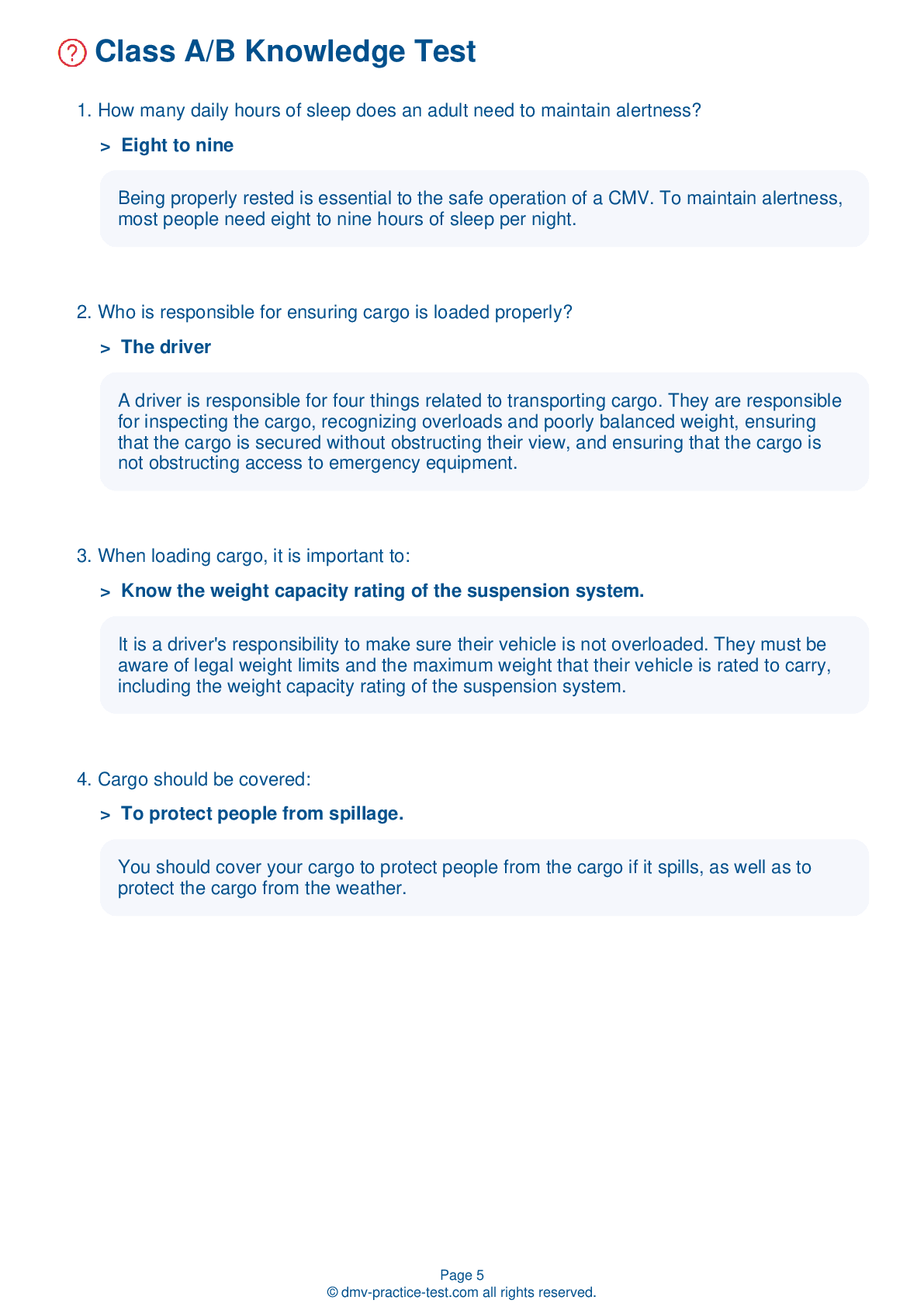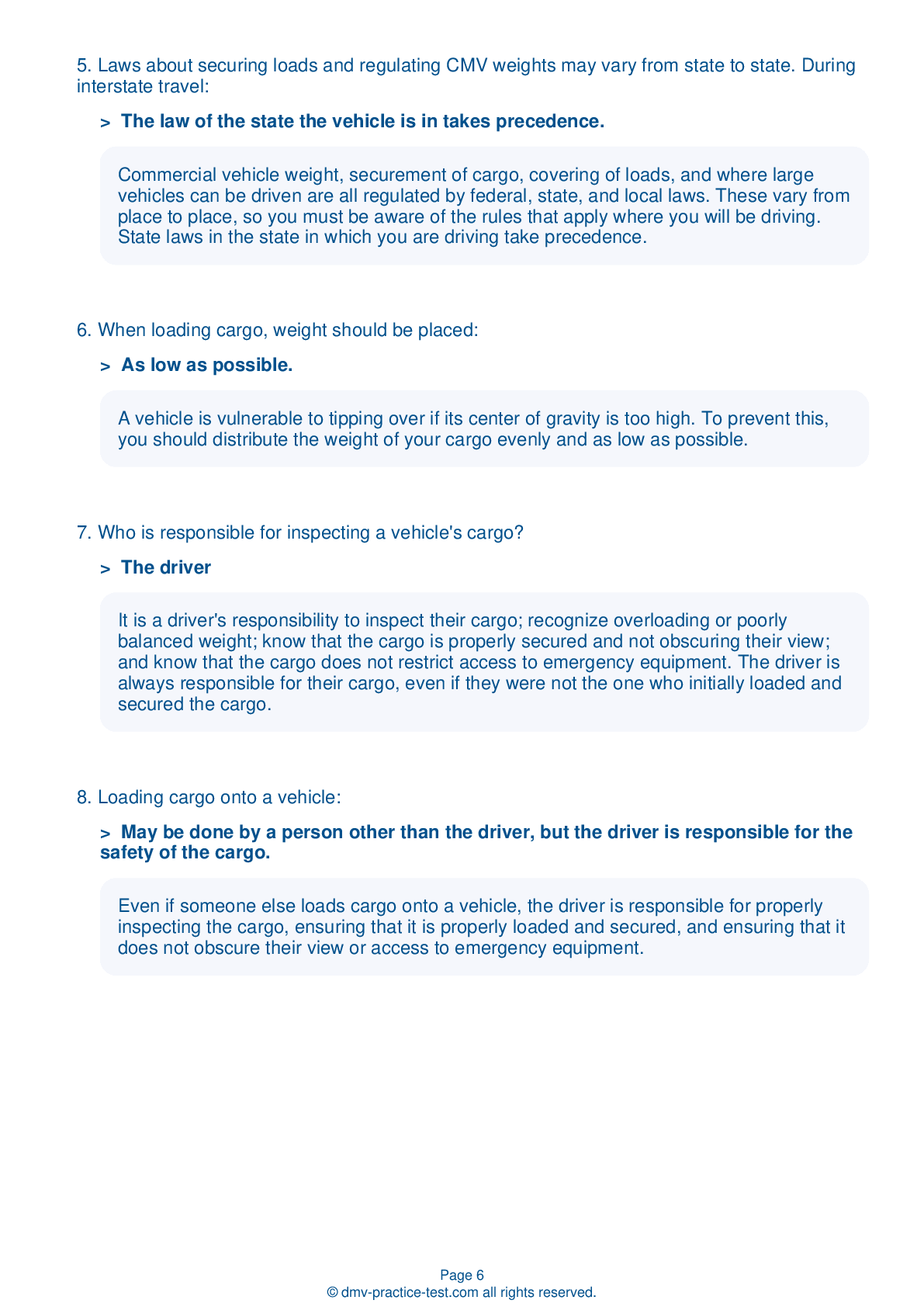Knowledge Test Class B #1
Class B Driving Test | Connecticut 2025 #1 Page 2 of 7
Train for FREE online with our Connecticut class B license test. The official exam test consists of several obligatory parts, with all of them checking your knowledge of different blocks of road rules. If you need to obtain a CT CDL class B permit in 2025, practice as much as possible. Free sample tests published on our website will help you check and improve your knowledge and boost your grades. Please bear in mind that CDL class B requirements may vary from state to state.
50
40
20
8 . If pulled off to the side of the road, you should:
Keep your door open to warn other motorists.
If you must stop and park on the side of the road, make sure to turn on your emergency flashers. This is especially important at night. Taillights are not an adequate when alerting other drivers because the drivers may mistakenly think your vehicle is moving normally and collide with it.
9 . Which of the following is not an example of a driving hazard?
An ice cream truck
Passing an accident scene can be hazardous because the people involved in the accident may not be watching traffic, and the scene itself may distract other passing drivers. Ice cream trucks can create hazardous conditions because they attract children who may not pay attention to nearby vehicles. Shoppers near the roadway are often paying attention to stores, not passing traffic.
10 . When leaving a vehicle unattended, a driver should:
Always apply the parking brake when leaving your vehicle unattended.
11 . When approaching a railroad crossing, you should:
Look to see if nearby plants are moving from the breeze created by a passing train
As a precaution, you should always approach a railroad crossing under the assumption that a train is coming. Do not rely only on signals or your hearing to indicate that a train is approaching.
12 . When you need to brake, how can you warn drivers behind you?
Change lanes.
To warn drivers behind you that you are about to slow down, it may be a good idea to first lightly tap your brake pedal a few times to make the brake lights flash.
13 . Alcohol is removed from the body:
The liver removes alcohol from the body at a fixed rate. Despite popular belief, tricks like drinking coffee or taking a cold shower will not speed up the process. The only way to become sober is to allow your body the time it needs to remove the alcohol from your system.
14 . Unsafely reaching for a phone is:
If you must use a mobile phone while driving, it must be in close proximity to you and easily reachable while you are securely fastened into your seat. It is dangerous and non-compliant to unsafely reach for a mobile phone, even if you plan to use a hands-free feature when speaking on the phone.
2025 Connecticut | Frequently Asked Questions
To acquire a CDL Hazmat endorsement in Connecticut, you must first have a Commercial Driver's License (CDL). Then, pass the Hazardous Materials Endorsement Knowledge Test. You also need to complete a federal security threat assessment (TSA background check), including fingerprinting. Visit your local DMV to start the process and get additional information.
To obtain a CDL Hazmat license, you must have a valid Commercial Driver's License (CDL). You are required to pass the Hazardous Materials Endorsement Knowledge Test. A federal security threat assessment, including fingerprinting and a background check by the Transportation Security Administration (TSA), must also be completed. You should have a clean driving record as well.
When applying for a CDL Hazmat endorsement, you'll need to provide proof of U.S. citizenship or lawful permanent residency, such as a valid U.S. passport or birth certificate. You'll also need your current Commercial Driver's License (CDL), social security card, and proof of Connecticut residency. A completed application form (H-170) is also required, available from the Connecticut DMV.
Yes, there is a dedicated written test for the CDL Hazmat endorsement. This test covers the necessary knowledge about the transportation of hazardous materials. It includes questions about loading and unloading hazardous materials, bulk packaging, and emergency response procedures. Passing this test is a prerequisite for obtaining the Hazmat endorsement on your CDL.
The CDL Hazmat endorsement written test in Connecticut covers a variety of subjects including identifying different types of hazardous materials, understanding shipping papers, placarding rules, containment rules, emergency response procedures, and safety protocols. It also tests knowledge on loading and unloading hazardous materials and the risks associated with each type of material.
Yes, there are extra charges associated with acquiring a CDL Hazmat endorsement. These include the application fee, fingerprinting fee, and the federal security threat assessment fee. The total cost can be over $100. However, the exact amount can vary and it's best to check with the Connecticut Department of Motor Vehicles for the most current fees.
Yes, a background check and security clearance are mandatory for the CDL Hazmat endorsement. The Transportation Security Administration (TSA) conducts a security threat assessment that includes fingerprinting and a review of criminal, immigration, and terrorism records. This is to ensure the safety and security of hazardous material transportation.
Yes, specialized training is required for the CDL Hazmat endorsement in Connecticut. Applicants must pass a written test that covers hazardous materials regulations and safety procedures. In addition to passing the test, they must also undergo a federal background check and fingerprinting. These requirements ensure that drivers are adequately prepared to handle hazardous materials safely.
No, you cannot transport hazardous materials without a valid CDL Hazmat endorsement in Connecticut. It is a federal requirement and it's illegal to do so without the proper endorsement. Violations can result in substantial fines, imprisonment, and disqualification from holding a commercial driver's license.
Yes, you can add the CDL Hazmat endorsement to your current CDL license. You'll need to pass the Hazmat knowledge test, undergo a TSA background check, and pay the necessary fees. It's not a new license, but an addition to your existing CDL.



